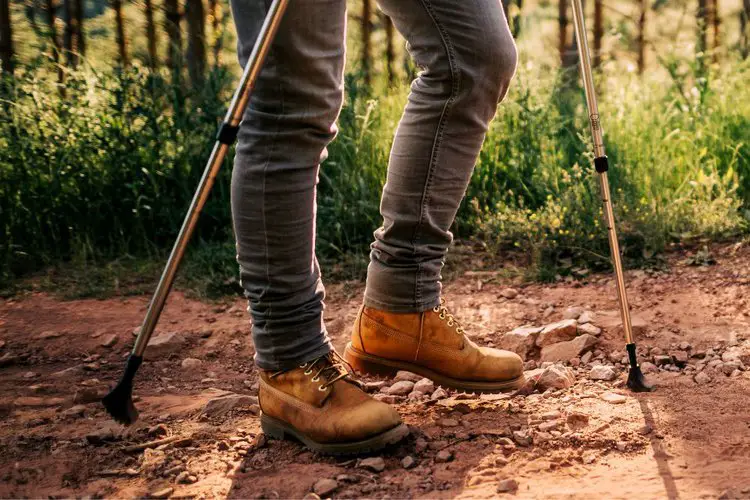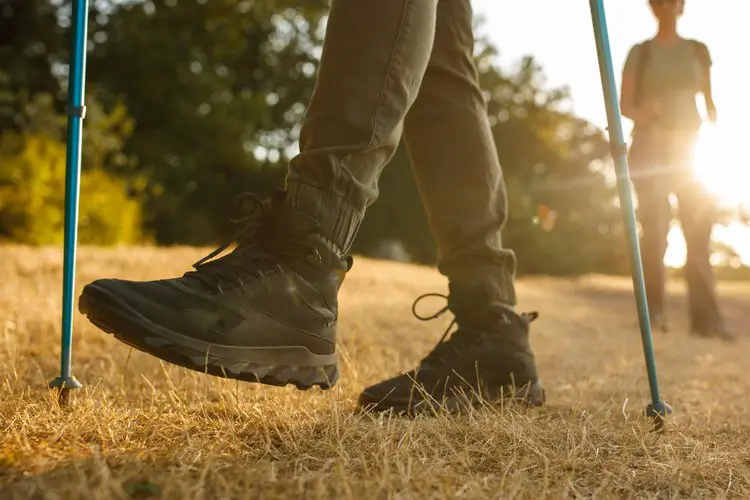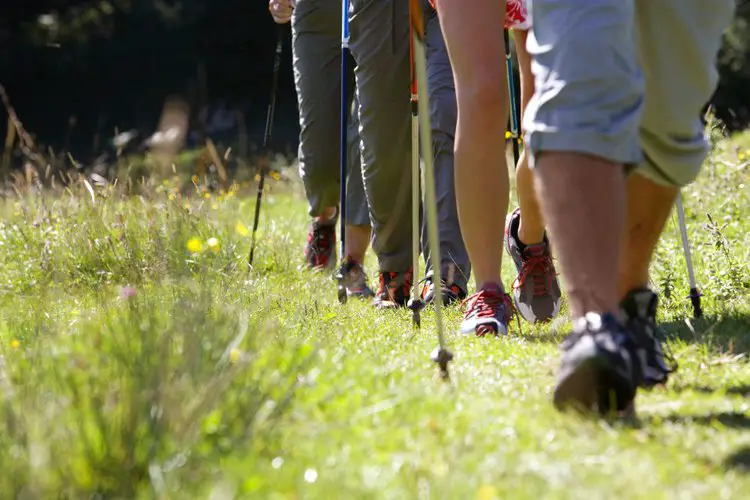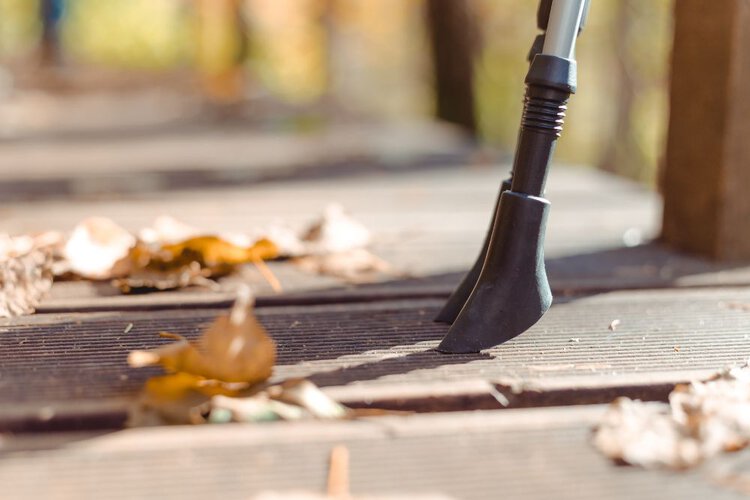Hiking poles are an essential piece of equipment for many hikers and outdoor enthusiasts.
They provide extra support, improve balance, and can even reduce fatigue during long hikes. But did you know that there are different tips available for hiking poles?
In this article, we’ll explore the different tips on hiking poles and their uses.
Key takeaways
| Type of Tip | Description | Pros | Cons |
| Carbide | A small metal point comes in direct contact with the ground. |
|
|
| Rubber tips/ feet | Wider and flatter than carbide tips; sometimes covers the metal spike at the end of the pole. Rubber feet look like small boots with grooves |
|
|
| Snow Baskets | Circular discs with holes that attach to the bottom of the pole, just above the carbide tip. |
|
|
| Mud basket | Circular discs (sometimes with holes)that attach to the bottom of the pole, just above the carbide tip. |
|
|
Contents
Different Types of Hiking Pole Tips: What are they used for?
Hiking poles typically come with one of five different types of tips: carbide, rubber tips, rubber feet, snow and mud baskets.
Let’s explore each of these tips in more detail.
1. Carbide Tips
Carbide tips are usually pointed, with a small metal point that comes in direct contact with the ground.
This design provides excellent traction and stability on rough terrain and loose surfaces such as dirt, rocks, and gravel.

Carbide tips are the most common type of hiking pole tip. They are made of tungsten carbide, which is a durable and long-lasting material that can withstand rough terrain.
Carbide tips are perfect for hiking on hard surfaces, like rocks and gravel, and provide excellent traction on slippery terrain. They are also resistant to wear and tear and are less likely to break or chip than other types of tips.
Carbide tips are also useful in icy or snowy conditions, as they can grip into the hard ice or packed snow, providing secure footing.
Pros:
- Provide excellent traction on hard surfaces such as pavement or rock
- Quieter than other tips, making them ideal for urban hiking or hiking with a group
- Offer a non-marking alternative for indoor or delicate surfaces
Cons:
- Can wear down quickly, especially on rough terrain
- Do not perform well on soft surfaces such as mud or sand
- Can get hot and sticky in hot weather
2. Rubber Tips
Rubber tips are typically wider and flatter than carbide tips (or sometimes, they cover the metal spike at the end of the pole).
The rubber provides a good grip on flat, hard surfaces, such as pavement or boardwalks, and helps to reduce the impact on joints, making them a good choice for urban or suburban walking.

These tips are made of soft rubber and provide a cushioned grip on hard surfaces. They are also quieter than carbide tips and are less likely to damage delicate surfaces like wood or tile.
- Standard Size fit Most Standard Poles Hiking – The trekking pole rubber feet tips / snow baskets /...
- Quality Rubber Tips for Trekking Poles – A quality proper interchangeable walking stick part for...
- Effectively Prolong the Service Life of Your Walking Sticks – Our walking stick tips made of...
Last update on 2023-11-10 / Affiliate links / Images from Amazon Product Advertising API
However, rubber tips may wear out faster than other tips, especially if used on rough terrain.
Pros:
- Provide excellent traction on hard surfaces such as pavement or rock
- Quieter than other tips, making them ideal for urban hiking or hiking with a group
- Offer a non-marking alternative for indoor or delicate surfaces
Cons:
- Can wear down quickly, especially on rough terrain
- Do not perform well on soft surfaces such as mud or sand
- Can get hot and sticky in hot weather
3. Rubber feet (boot tips)
Rubber feet, also known as rubber tips or rubber ferrules, are a common type of tip used for hiking poles.
They are typically made of durable rubber material and have a wide base with grooves that provides good traction and stability on hard surfaces like pavement, rock, or concrete.

Rubber feet are particularly useful for hikers who need to use their poles on surfaces where metal tips might damage the terrain or cause excessive noise.
They also provide a good grip on smooth surfaces, like wet rocks or slick pavement, making them a popular choice for urban hiking and walking.
- Quality Rubber Trekking Pole Tips: A quality proper interchangeable walking stick part for different...
- Standard Size fit Most Standard Poles Hiking: The trekking pole rubber feet tips / snow baskets /...
- It Can Effectively Prolong the Service Life of Your Walking Sticks: Our walking stick tips made of...
Last update on 2023-11-11 / Affiliate links / Images from Amazon Product Advertising API
One of the main advantages of rubber feet is that they are gentle on the environment and won’t damage delicate surfaces like fragile alpine plants or historic trails.
They also tend to be quieter than metal tips, making them a good choice for hikers who prefer a more stealthy approach.
However, rubber feet do have some downsides. They may not be as durable as metal tips, and can wear down or become damaged over time.
They also tend to be less effective on soft surfaces like dirt or mud, where they can sink in and provide less stability.
Pros:
- Provide traction and stability on hard or rocky terrain
- Help absorb shock and reduce vibration on hard surfaces, reducing the impact on your joints
- Can help protect the pole tips from damage by preventing them from hitting hard surfaces
- Can be removed easily if not needed or for storage
Cons:
- Can slip on wet or muddy terrain, reducing stability and support
- Can wear out over time and need to be replaced
- May not be as effective on very soft or muddy terrain
4. Snow Baskets
Snow baskets are designed for use in snow or soft soil. They are circular discs that attach to the bottom of the pole, just above the carbide tip.
This design provides extra surface area, which helps to prevent the pole from sinking too deep into the snow or soil.

Snow baskets are typically larger than other tips and come in various shapes and sizes. They are especially useful for hikers who plan to do winter hiking or snowshoeing.
- Anti-Slip---Made of high quality rubber, which will be lightweight and durable
- Provide with Protection---Large contact area provides additional support, effectively avoiding the...
- Support your Kick---Make trekking pole and walking sticks go smoothly in any terrain
Last update on 2023-11-11 / Affiliate links / Images from Amazon Product Advertising API
Pros:
- Prevent the pole from sinking too deep into the snow and provide better stability on soft and slippery surfaces
- Reduce the risk of injury by preventing the pole from getting stuck in the snow
- Can be easily attached or removed depending on the hiking conditions
Cons:
- Not suitable for hiking on dry or rocky terrain as they can catch on obstacles and reduce stability
- Can add extra weight to the poles, which may be a concern for some hikers
- May not be necessary for hikers who do not frequently hike in snow or soft terrain.
5. Mud basket
A mud basket is a small attachment that can be added to the end of a hiking pole to help prevent it from sinking too deeply into soft or muddy terrain.
The basket is typically made from plastic or rubber and sits just above the point where the pole touches the ground. It is designed to catch debris and mud that might otherwise get stuck in the tip of the pole, causing it to sink into the ground and making it harder to use.

Mud baskets are especially useful in wet or muddy conditions, as they can help prevent the pole from sinking too deeply into the ground and getting stuck.
- Replacement baskets for trekking hiking and walking poles
- Screw on secure fits threaded pole tips
- Serrated basket edge for increased grip
Last update on 2023-11-10 / Affiliate links / Images from Amazon Product Advertising API
This can help hikers maintain their balance and stability on slippery terrain, which is especially important when traversing steep or rocky slopes.
In addition to providing added stability and support, mud baskets can also help protect the environment by reducing the amount of damage caused by hikers walking on soft or fragile ground.
Most hiking poles come with detachable mud baskets that can be easily removed or swapped out depending on the terrain and conditions.
Some models also come with interchangeable tips and baskets that can be used for different types of hiking or outdoor activities, such as snowshoeing or cross-country skiing.
Pros:
- Provides more stability and support on soft, muddy terrain
- Helps prevent the pole from sinking too deep into the ground
- Can help protect the pole tips from damage by preventing them from getting stuck in soft terrain
- Can be removed easily if not needed or for storage
Cons:
- Can get in the way on hard or rocky terrain, causing the pole to catch or snag
- Can add weight to the poles, making them slightly heavier
- May not be necessary on every hike, and can take up space in your backpack when not in use
How to Choose the Right Tips for your Trips
Here are some specific examples of choosing the right tips for your hiking poles based on different factors.
Terrain

If you’re planning to hike on rocky or uneven terrain, you may want to choose carbide or steel tips, as these materials are more durable and can provide better traction on rough surfaces.
For hiking on flat, hard surfaces like pavement or concrete, rubber tips may be a better choice, as they can provide a better grip and reduce the impact on your joints.
Weather conditions

If you’re hiking in snowy or icy conditions, you may want to use snow baskets to prevent your poles from sinking into the snow.
These baskets are designed to increase the surface area of the tip, providing better support and stability in snow or soft soil.
For hiking in muddy or wet conditions, rubber tips may be a good choice, as they can provide a better grip on slippery surfaces.
Personal preferences:
Some hikers may prefer rubber tips for their hiking poles as they offer better traction and are quieter on hard surfaces.
Others may prefer metal tips for more rugged terrain, as they can provide better stability and support.
Replacement options

When choosing the tips for your hiking poles, it’s worth considering the availability of replacement tips for your chosen type.
For example, rubber tips are usually easy to find and replace, while carbide or steel tips may be more difficult to find.
By considering these specific factors, you can choose the right tips for your hiking poles that will best suit your needs and preferences on the trail.
- 10 Pack In A Set- 4 Trekking Pole Rubber Tips, 2 Boot Tips, 2 Snow Baskets, 2 Mud Baskets, Suitable...
- Extra Durable- Made Of High Quality Vulcanized Rubber With Metal Washer To Prevent Wear Through,...
- Universal- These Rubber Tips, Mud Baskets And Snow Baskets Are Designed To Fit A Majority Of The...
Last update on 2023-11-10 / Affiliate links / Images from Amazon Product Advertising API
Last words
In conclusion, choosing the right type of hiking pole tip is essential for a comfortable and safe hiking experience. Each type of tip has its advantages and disadvantages, and selecting the appropriate tip depends on the terrain and weather conditions.
For example, carbide tips are ideal for rough terrain and icy conditions, while rubber tips and rubber feet are great for urban hiking or on hard, rocky terrain.
Snow baskets are a must-have for hikers who plan to do winter hiking or snowshoeing, and mud baskets are suitable for soft and muddy terrain.
Regardless of the type of tip you choose, it’s crucial to maintain and replace your hiking pole tips regularly to ensure optimal performance and safety.






